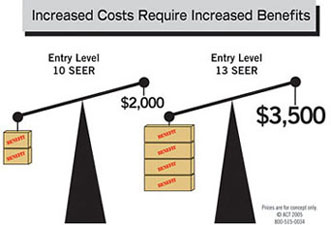What's Behind Higher Prices?
Here are five reasons for 13 SEER's higher prices:1. Material costs: SEER increases as condensers get bigger.
Bigger condensers use more material, which drives up costs. The bulk of air conditioning equipment is made of steel, aluminum, and copper. Like oil, the supply of these commodities diminishes each time their components are taken out of the ground. Demand will increase as the world adds 3 billion new consumers. If demand outpaces supply, expect prices to rise.
2. Shipping costs: Transportation costs will soar.
Fuel, insurance, and vehicle costs have risen steadily for years. Now add the fact that each 13-SEER unit could take up 30 percent to 80 percent more space than a 10-SEER unit and watch transportation charges skyrocket. The cost to pay for added deliveries must be tacked on to the price of equipment.
3. Handling and storage costs: Larger items are harder to handle and more costly to store.
Storage is a critical link in the customer satisfaction chain. Today, contractors expect the right product to be stored at the right place so it can be delivered at the right time, undamaged and ready to install. Due to the larger size 13 SEER brings, many distributors will add expensive warehouse space to maintain their current level of customer satisfaction. These costs will ultimately be passed on to consumers.

"Hook and book" contractors can't get away with tying 13-SEER condensing units to the existing evaporator coils like they did with 10 SEER. It won't work.
Instead of a service technician installing a condensing unit the day the compressor was found bad, it could take a couple of days before a sheet metal technician is scheduled to install the new 13-SEER coil. Tomorrow's entry-level systems must be installed by well-paid, highly trained technicians because they are less forgiving, especially when soon-to-be-mandatory R-410a is added to the installation puzzle.
5. Sales costs: 13 SEER costs more to sell.
Today's "either/or" sales pitch won't work tomorrow. When consumers don't fully understand the benefits of waiting a couple of days for a lifetime of customized comfort, many will go for the repair that promises cooling tonight.
Today, a typical scenario might be summed up this way: "I can either replace the compressor in your old unit for $1,000 or install a high-efficiency 10-SEER unit for $2,000."
In 2006, however, the customer might hear, "I can either replace the compressor in your old unit for $1,000 or install an ultra-efficient 13-SEER system for $3,500."
Instead of a $1,000 price difference, consumers now must justify spending $2,500 more than the repair. The only way to bridge the gap between a $1,000 repair and a $3,500 entry-level replacement is by adding $2,500 in benefits the customer wants and is willing to pay for now.
As the gap widens, the sale must move from technicians selling units to well-paid professionals selling customized comfort. Contractors who attempt to sell 13 SEER the way they sold 10 SEER face the aggravation and liability of repairing worn-out equipment instead of installing comfort at the profit needed to ensure success.
New Challenges Require New Strategies
Due to strained budgets, poor credit, or limited income, many consumers must take the $1,000 repair over the $3,500 purchase, no matter how good the features, benefits, or financing. The irony is 13 SEER became mandatory to help consumers save energy; soon those who need it most may not be able to afford it at all.To keep from going backwards, every HVAC contractor needs a strategy to restore lost replacement business. Here's an example: Find active home remodelers who may be anxious to replace their working HVAC equipment with lifestyle-enhancing customized comfort.
The average age of the 120 million homes in America is 32 years. In the last 10 years, over 45 percent of homeowners spent $10,000 or more on major home upgrades. Lifestyle-enhancing customized comfort is the best home improvement most consumers will ever make. Reasons why include:
1. Other upgrades require it. Forty-five percent of remodel spending involves changes to interior spaces like room additions and new kitchens with oversized refrigerators, stoves, and ovens. Unaddressed new heat loads reduce comfort and enjoyment of the entire new project.
2. It's the only home improvement that pays its way. The best comfort is delivered by properly designed, variable-speed, multiple-stage, high-efficiency comfort equipment. The system that provides the best comfort can also provide the lowest heating and cooling bills. Better comfort is one of the few things consumers can buy that could easily pay for itself.
3. The best benefits are available. Consumers can protect their family, home, and furnishings by having comfortable, purified air delivered to every room by a whisper-quiet, energy-saving system that is protected by a full warranty and trustworthy people on call 24 hours a day.
To be a leader in this lucrative growth market, you don't need to get into the home remodeling business - you just need to get in the home remodeler's mind. To be there and help them start thinking about their next remodeling project:
Steve Howard is the founder of The ACT Group. He can be reached at either 602-678-1055 or steve@nopressureselling.com.
Publication date: 04/18/2005